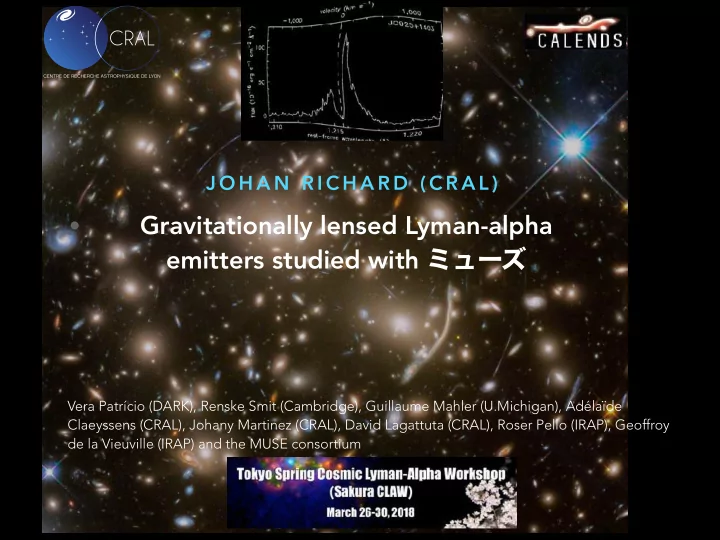

J O H A N R I C H A R D ( C R A L ) Gravitationally lensed Lyman-alpha • emitters studied with ミューズ Vera Patrício (DARK), Renske Smit (Cambridge), Guillaume Mahler (U.Michigan), Adélaïde Claeyssens (CRAL), Johany Martinez (CRAL), David Lagattuta (CRAL), Roser Pello (IRAP), Geoffroy de la Vieuville (IRAP) and the MUSE consortium
MUSE on lensing clusters - Use the power of magnification from gravitational lensing. - MUSE mosaics to cover the high amplification regions - ~ 30 clusters observed during GTO and non-GTO programs Science goals - Spectroscopic redshift for multiple images: mass models and magnification estimates - Low-luminosity / Mass galaxies (in particular LAEs). - Extended arcs - resolved properties 2 arcmin Mahler et al. 2018, MNRAS 473, 663
M MUSE observations of the Frontier Fields Mahler et al. 2018, MNRAS 473, 663 - 171 lensed LAEs in a 2x2 MUSE mosaic of 4-6hrs per pointing
M MUSE observations of the Frontier Fields Bina et al. 2016, A&A 594, 14 de la Vieuville et al. 2018, in prep.
S M A C S 2 0 3 1 Richard et al. 2015, MNRAS 446, 16
S M A C S 2 0 3 1 Patrício et al. 2016, MNRAS 456, 4191 - Multiple structure, extended Lyman- α halo around a compact SF galaxy - Line profile almost identical across the halo, small shift in peak wavelength - CIII] kinematics!
S M A C S 2 0 3 1 Patrício et al. 2016, MNRAS 456, 4191 - Multiple structure, extended Lyman- α halo around a compact SF galaxy - Line profile almost identical across the halo, small shift in peak wavelength - CIII] kinematics!
Z > 4 S T U D I E S Ly- α (VIMOS) [ ΟΙΙ ] (SINFONI) RCS0224 arc (z=4.89) Swinbank et al. 2007, MNRAS 376, 479 - Compatible with starburst galaxy surrounded by a bipolar outflow, escaping at v ~ 500 km/s
RCS0224 with MUSE Smit et al. 2017, MNRAS 467, 3306 - One of the highest redshifts (z=4.9) extended arcs - Compatible with starburst galaxy surrounded by a bipolar outflow, escaping at v ~ 500 km/s - Lyman-alpha profile relatively similar across the nebula except in one direction (high velocity excess) - Extended CIV emission at z=4.9 across the continuum-bright arc
E X T E N D E D LY- A E M I S S I O N Vanzella et al. 2017, MNRAS, 465, 3803
E X T E N D E D LY- A E M I S S I O N - Several extended Lyman-alpha nebulae per cluster core: probe scales < 1 kpc - Overdensities of LAEs: diffuse emission between sources at the same redshift. - Spec-z improves SED fitting to derive physical properties ( Martinez et al. in prep. )
S U M M A RY - MUSE + lensing clusters is the best combination to probe down to the faintest luminosities of LAEs - Observations of cluster cores identify many extended Lyman-alpha nebulae with a better intrinsic resolution than in blank fields. Adaptive Optics will help! - Many follow-ups are possible with JWST, in particular with NIRSpec (MSA or IFU): kinematics of rest-optical lines, other diagnostics
T H A N K Y O U
Recommend
More recommend